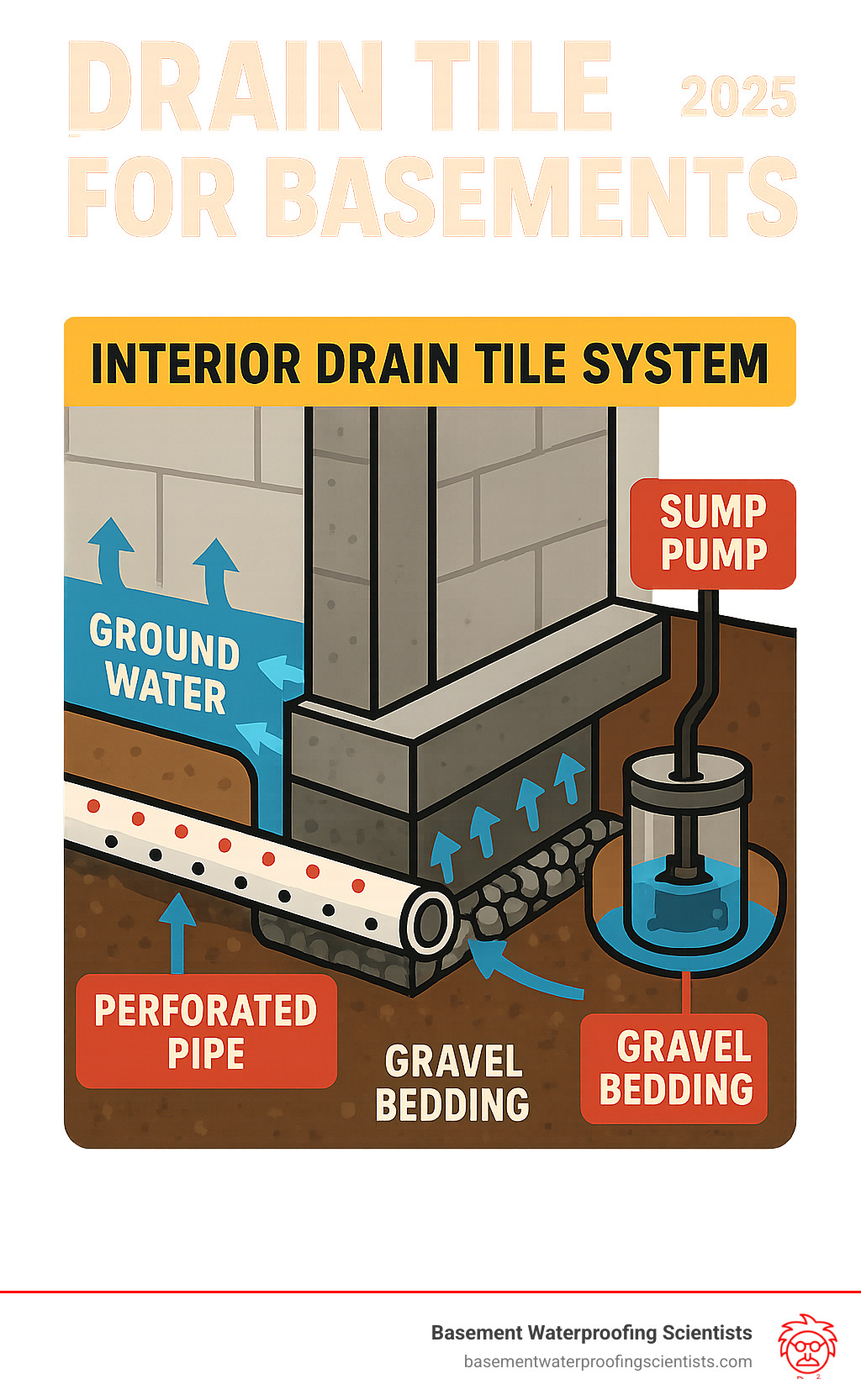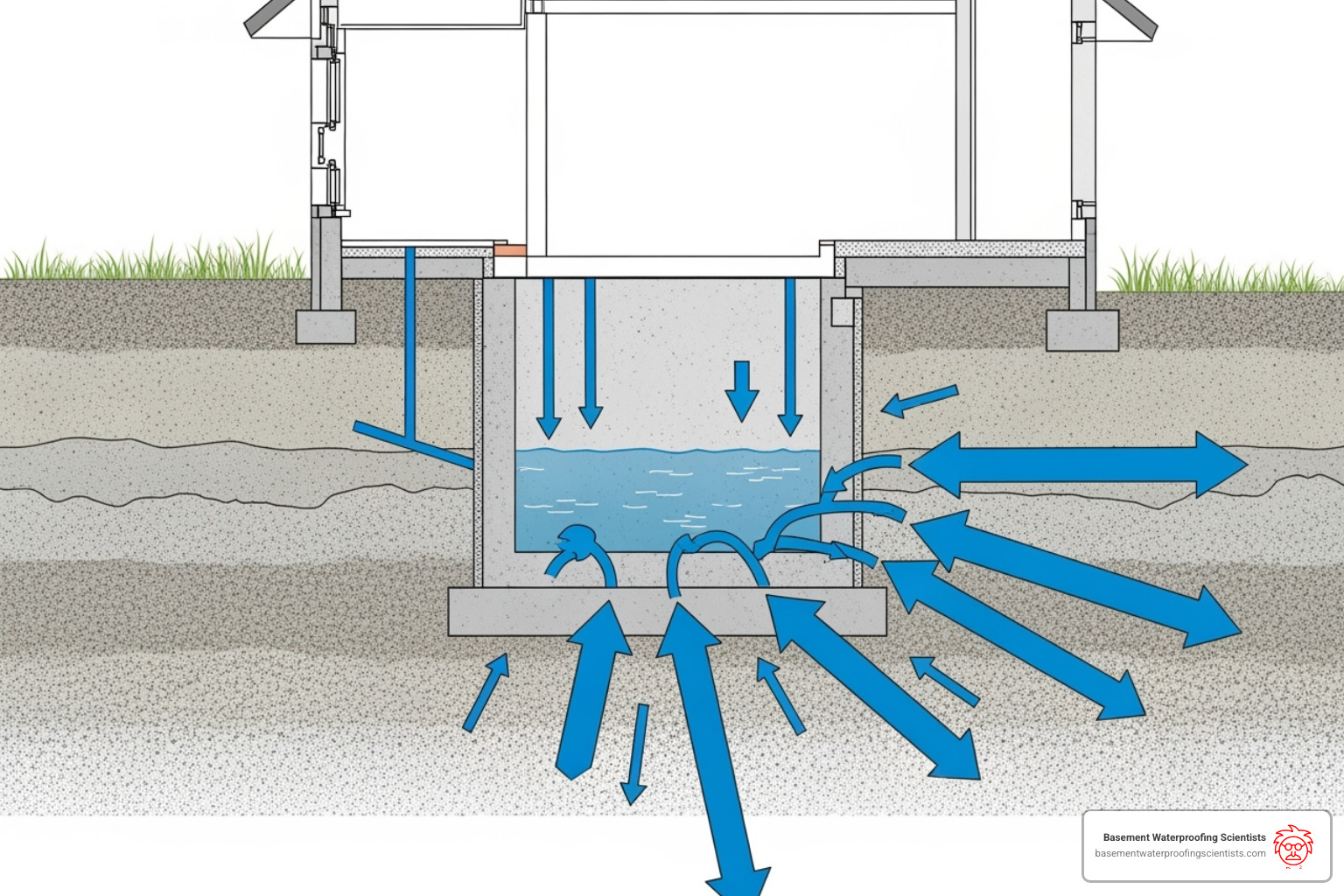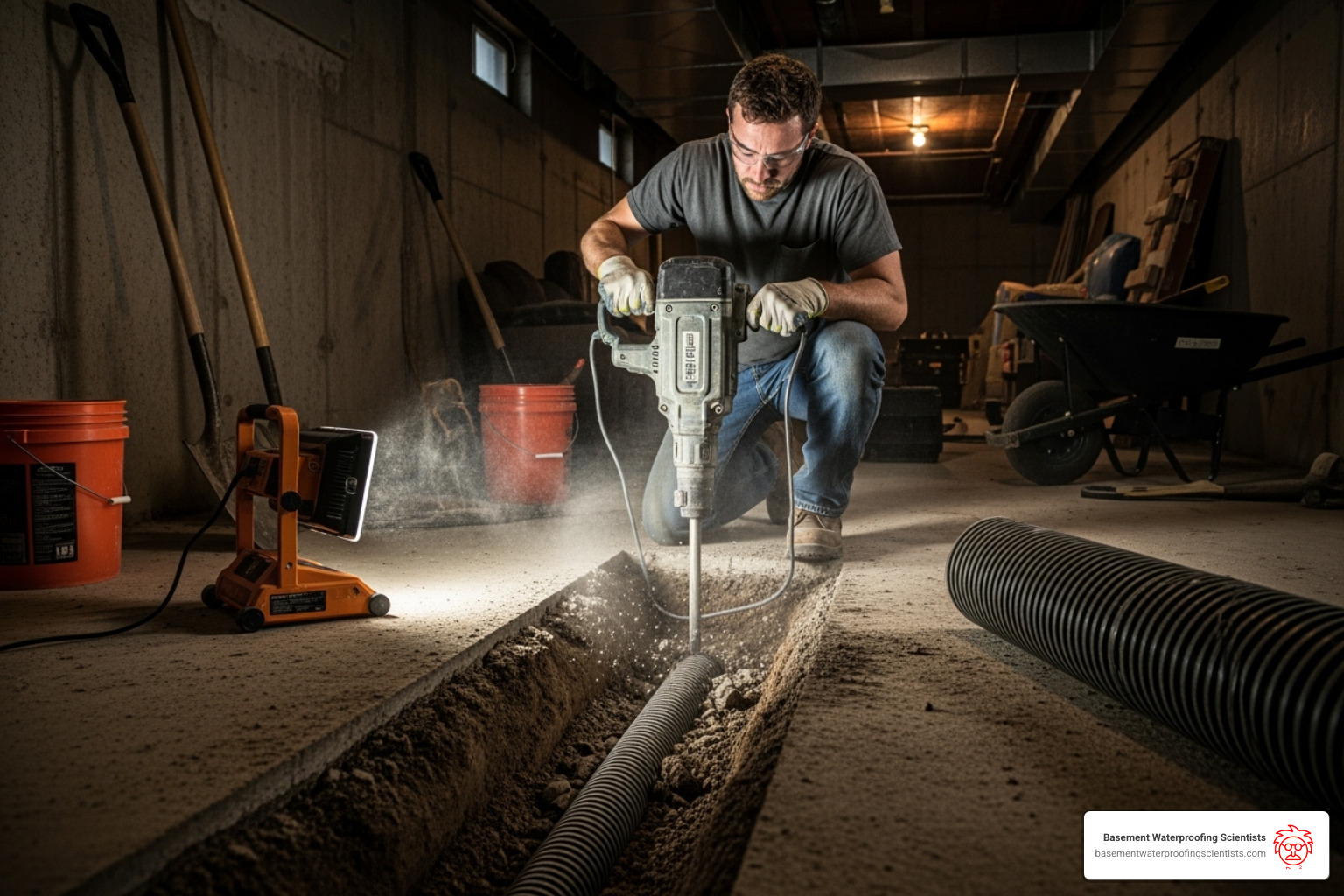Why Drain Tile for Basement is Your Best Defense Against Water Damage
A flooded basement is a homeowner’s nightmare. Beyond property damage, basement moisture is a serious health concern, as over 50% of the air you breathe upstairs originates from your home’s lower level. A drain tile for basement system is an underground drainage solution that collects and redirects water away from your foundation before it can get inside. Despite the name, drain tile isn’t tile but a perforated pipe system surrounded by gravel, giving groundwater an easy path away from your home.
Quick Answer for Homeowners:
- What it is: Perforated pipes installed around your basement perimeter
- How it works: Collects groundwater and directs it to a sump pump
- Best type: Interior systems for existing homes (less invasive, more cost-effective)
- Cost: Part of basement waterproofing systems averaging $4K-$8K
- When you need it: Water stains, musty odors, puddles, or efflorescence in basement
The term “drain tile” dates back over 2,000 years to when actual clay tiles were used for drainage. Today’s systems use modern PVC or plastic pipes, but the name stuck.
Water always chooses the path of least resistance. When groundwater builds up around your foundation, it creates hydrostatic pressure that forces water through any crack or weak point. A properly installed drain tile system gives that water an easier route to follow, carrying it safely away from your home.
I’m Darin Garvey, and with over 30 years of experience in basement waterproofing, I’ve seen how a quality drain tile for basement system can transform a damp, unusable space into a dry, healthy part of your home. At Basement Waterproofing Scientists, we’ve helped countless Philadelphia-area homeowners solve persistent water problems with targeted drainage solutions.

What is Basement Drain Tile and Why Do You Need It?
When we talk about drain tile for basement systems, we’re discussing one of the most effective ways to protect your home’s foundation from water damage. Think of it as an underground security system that works 24/7 to keep your basement dry.

A drain tile for basement system is a network of perforated pipes that intercepts groundwater before it can reach your foundation. These pipes collect water from the surrounding soil and redirect it to a sump pump, which safely removes it from your property.
Despite the name, modern systems use durable PVC pipes, not tiles. The term is a holdover from 19th-century agricultural drains made of fired clay, as detailed in the history of drain tile.
The main culprit in basement water problems is hydrostatic pressure. After heavy rain, saturated soil exerts immense pressure on your foundation. This hydrostatic pressure forces water through any crack or weak point it can find.
How do you know if you need a drain tile system? Look for these warning signs: water stains on walls or floors, efflorescence (a white, chalky residue on concrete), musty odors indicating mold, or puddles after rain.
These signs point to serious issues. Persistent water pressure can lead to foundation damage, including cracks and costly structural problems. It also creates poor indoor air quality, as over 50% of the air you breathe upstairs comes from your basement. A damp basement becomes a mold factory, pumping allergens throughout your home.
Before committing to a drain tile solution, check simpler fixes. Ensure your gutters are clean and downspouts extend at least six feet from your foundation. The soil around your home should also slope away from the house. If these steps don’t solve the problem, a comprehensive Wet Basement Repair with a drain tile for basement system is your best long-term investment.
How a Drain Tile System Works
A drain tile for basement system works by giving groundwater an easy escape route, intercepting it before it can damage your foundation. Water always follows the path of least resistance, and a drain tile system provides a much easier path than forcing its way through your concrete walls.

The water collection process begins when groundwater meets the perforated pipe installed around your basement’s interior perimeter. The holes in the pipe allow water to enter easily. The pipe sits in a bed of clean, washed gravel (typically 1/2 to 3/4 inches), which acts as a filter and stable base.
Filter fabric wraps around the gravel bed, allowing water to pass through while blocking fine soil particles that could clog the system. For homes with concrete block foundations, we drill weep holes into the bottom blocks. This allows any water trapped inside the hollow cores to drain directly into the new drainage system.
The collected water then travels by gravity to a centrally located sump basin, a collection pit installed flush with your basement floor. Inside the basin, a reliable sump pump waits. When water levels rise, a float switch activates the pump, which pushes the water through a discharge line that carries it safely away from your home.
This seamless sump pump integration prevents hydrostatic pressure from building up and keeps your basement dry. Our comprehensive Basement Sump Pump Installation service ensures every component works together perfectly.
Types of Drain Tile Systems: Interior vs. Exterior
When choosing a drain tile for basement system, you have two main options: exterior and interior. For most existing homes, an interior system is the more practical and effective choice.
| Feature | Interior Drain Tile System | Exterior Drain Tile System |
|---|---|---|
| Cost | Generally more cost-effective (avg. $4K-$8K for complete system) | Significantly more expensive (avg. $25K-$50K for retrofit) |
| Installation | Less invasive, faster (1-2 days), can be done year-round | Highly invasive, disruptive, involves major excavation, impacts landscaping |
| Effectiveness | Highly effective, manages hydrostatic pressure directly, less prone to clogging | Effective for new construction, prone to clogging over time, doesn’t prevent water from wall cracks |
| Maintenance | Easier access for maintenance, less prone to clogging | Difficult to service (requires re-excavation), high clogging risk |
| Retrofitting | Ideal for existing/older homes | Very difficult and costly for existing homes |
| Water Source | Collects water from floor/wall joint and under slab | Collect water from outside foundation walls |
Exterior Drain Tile Systems
Exterior systems are installed around the outside of the foundation, intercepting water before it reaches the walls. While this is a great option for new construction when the foundation is already exposed, it’s a challenging and expensive solution for existing homes.
For a retrofit, installation requires massive excavation around the entire foundation, disrupting landscaping, decks, and driveways. The primary drawback is the clogging risk. Located in the “mud zone,” these exterior pipes are prone to blockage from soil, silt, and tree roots, requiring re-excavation for service. The cost to retrofit an exterior system can run from $25,000 to $50,000 or more, making it impractical for most homeowners.
Interior Drain Tile Systems
Interior systems are the practical and preferred solution for most existing homes. They manage water that reaches the foundation rather than trying to block it entirely. The installation is far less disruptive, as we work entirely inside your basement, removing a small section of concrete at the floor’s edge. Your landscaping and driveway remain untouched.
Cost-wise, interior systems are much more reasonable, typically falling within the $4,000 to $8,000 range for a complete waterproofing system. They are highly effective because they operate in a “clean water zone.” Water is naturally filtered by soil and gravel before reaching the pipe, minimizing clog risk. The system manages hydrostatic pressure directly by providing an easy escape route for water under the floor.
Maintenance is also simpler, as the system is accessible from inside the basement. At Basement Waterproofing Scientists, our Interior Drainage System is designed for effectiveness, affordability, and long-term reliability in existing homes.
Best Practices for Installing an Effective Drain Tile for Basement
Installing a drain tile for basement system is not a simple DIY project. It requires specialized equipment, precision, and expertise to ensure long-term success, making professional installation the recommended choice.

A properly installed system can protect your home for decades, but cutting corners leads to failure. Understanding the process and materials is key to evaluating a professional’s approach.
Key Installation Steps for an Interior Drain Tile for Basement
The installation of an interior drain tile for basement system follows several key steps. First, a thorough assessment identifies water entry points to plan the layout. Next, an 18-inch strip of concrete is removed from the floor’s perimeter. A trench is dug down to the footing, and a bed of washed gravel is laid. The perforated drain pipe is placed on the gravel, with holes facing down to allow water entry from below. For block foundations, weep holes are drilled into the bottom blocks to release trapped water. The entire system is sloped toward the sump basin, allowing gravity to carry water to the pump. Finally, the trench is backfilled with more gravel, covered with filter fabric, and new concrete is poured, leaving a seamless finish.
Choosing the Right Materials for a Drain Tile for Basement
The materials used for your drain tile for basement system directly impact its longevity. Trying to save a few dollars on inferior materials always costs more in the long run.
Rigid PVC pipe is superior to flexible corrugated pipe. Its smooth interior ensures excellent water flow and resists the sediment buildup that can clog corrugated pipes over time.
Clean, washed gravel (1/2 to 3/4 inch) is essential. It provides optimal drainage and stability without the fine particles that can clog the system.
A quality sump pump is the heart of the system. A reliable pump, paired with a battery backup system, is crucial for protection during severe storms, especially if the power goes out. A battery backup ensures your drain tile for basement system continues protecting your home when you need it most.
Professional installation ensures all these components work together seamlessly. You can learn more about the investment involved through our Drain Tile Installation Cost guide, but a properly installed system is one of the best long-term investments you can make in your home.
Long-Term Benefits and Professional Installation
Investing in a drain tile for basement system is about protecting your home’s future. It’s an insurance policy that pays dividends in structural integrity, health, and home value.
Your Foundation Will Thank You
A drain tile for basement system protects your foundation by relieving hydrostatic pressure. This prevents foundation cracks, bowing walls, and other serious structural damage, keeping your foundation stable for decades.
Breathe Easier in Your Own Home
A dry basement significantly improves your home’s air quality. Since over 50% of upstairs air originates from the lower level, eliminating dampness prevents mold, mildew, and allergens from circulating throughout your home. This means no more musty odors or related respiratory concerns.
Your Home’s Value Gets a Boost
A drain tile for basement system is an attractive feature for potential buyers, signaling a well-maintained home. It also makes the basement a usable space for a family room or home office. A history of water problems, on the other hand, can significantly lower your home’s value.
Peace of Mind is Priceless
Enjoy peace of mind during heavy rainstorms, knowing your basement will stay dry. No more rushing downstairs to check for puddles or worrying about water damage.
Why Professional Installation Makes All the Difference
While the materials seem simple, the installation of a drain tile for basement system is complex. Proper execution is critical, as mistakes are expensive to fix.
With 30 years of experience, Basement Waterproofing Scientists understands local soil and water conditions. We don’t use cookie-cutter solutions. Our specialized diagnostic equipment pinpoints the exact source of water problems, allowing for a targeted, more affordable repair.
We back every drain tile for basement installation with a lifetime guarantee. Before choosing a contractor, always verify their credentials with organizations like the Better Business Bureau. Your home deserves the best protection available through professional Foundation Repair and Waterproofing.
Frequently Asked Questions about Basement Drain Tile
As a waterproofing professional with three decades of experience, I’ve answered thousands of questions about drain tile for basement systems. Here are the most common ones.
How long does a drain tile system last?
A professionally installed interior drain tile for basement system using high-quality rigid PVC pipe can last for the life of your home. The piping itself is virtually maintenance-free. The key to longevity is the sump pump, which is a mechanical device requiring periodic maintenance and eventual replacement (typically every 5-10 years). Regular sump pump care ensures the entire system protects your basement for decades.
Is a French drain the same as a drain tile?
Yes, in the context of basement waterproofing, the terms are used interchangeably. Both refer to a perforated pipe in a gravel-filled trench that relieves hydrostatic pressure. A French Drain in Basement is another name for an interior drain tile for basement system. Both describe the same proven solution for keeping basements dry.
Can drain tile be installed in older homes?
Absolutely. Interior drain tile for basement systems are the ideal solution for older homes. Many were built with inadequate or now-failing drainage systems. An interior system can be installed without the massive cost and disruption of exterior excavation, preserving landscaping and driveways. This makes it a cost-effective way to add modern waterproofing to an older home, changing a damp, unusable basement into a dry, valuable space. Installation is typically completed in 1-2 days as part of a waterproofing project averaging between $4,000 and $8,000.
Secure Your Home with a Professional Drainage Solution
A drain tile for basement system is more than a repair; it’s a long-term investment in your home’s health and structural integrity. It’s a permanent solution to protect your foundation from water damage.
For most existing homes, an interior system is the most effective and practical solution, delivering superior performance without the disruption of exterior excavation. The peace of mind that comes with a professionally installed system is priceless. No more rushing to the basement during storms or worrying about musty smells. Instead, you get a dry, usable space that adds value to your home.
At Basement Waterproofing Scientists, our 30 years of experience is improved by specialized diagnostic equipment that pinpoints the exact source of water entry. This precision allows us to fix your specific leaks efficiently, saving you money. Most of our solutions, including drain tile for basement systems, range from $4,000 to $8,000.
We back every installation with our lifetime guarantee because we believe in doing the job right the first time. There’s only one chance to install your system correctly, and we take that responsibility seriously.
Don’t let water problems threaten your home’s foundation or your family’s health. A damp basement affects air quality throughout your house, and foundation damage only gets more expensive over time. Take action now to protect your investment.
Ready to explore how a professional Basement Drain Systems solution can transform your basement? We’re here to help homeowners across Pennsylvania, New Jersey, and Delaware secure their foundations for decades to come. Your dry basement is just a phone call away.

